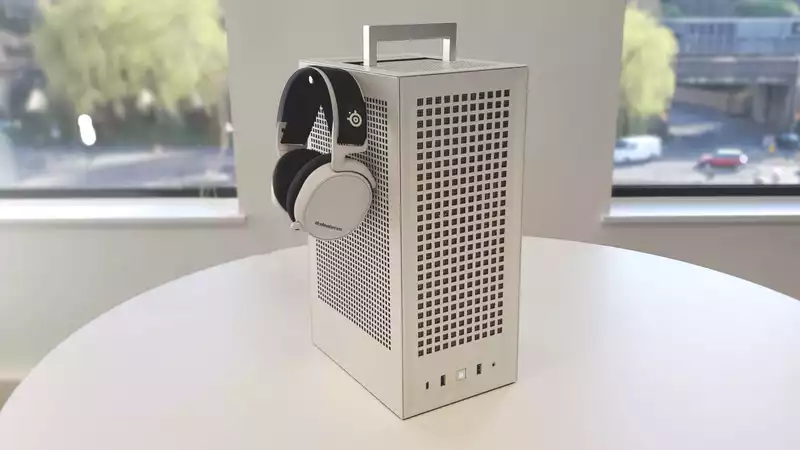There is something uniquely industrial about the almost utilitarian design of the mostly metal Hyte Revolt 3 mini-ITX PC case. Doubling down on the angular cubic aesthetic, every aspect of the exterior design is unashamedly sharp. Except for the rounded, pop-out headphone holder. And even now, I'm not sure if I like this understated approach or if it's simply basic.
But what I do know is that this is an excellent modern case for building your next Mini-ITX PC, supporting a wide range of components and not having to worry about riser cables.
This case is another small case with the same kind of cubic vertical design popularized by the Xbox Series X and made into a PC flame by the NZXT H1. But now comes the NZXT H1 V2 revision, which fixes the riser cable burn-in problem and improves on an otherwise excellent design.
The Hyte Revolt 3 is remarkably similar to the H1, with the notable difference being that the two companies went in different directions with their internal design choices. The lack of riser cables is one of them, but that doesn't mean that the GPU selection is any less restrictive.
You can't install anything over 58 mm thick, but you can still choose from a number of fat graphics cards, even cheapies like the Asus TUF RTX 3080. Even if the motherboard is mounted perpendicular to the GPU, the Revolt 3 can accommodate everything in nearly the same footprint.
Another advantage is the ability to mount a 280mm AIO Liquid CPU cooler without modification. Any off-the-shelf cooler with a 35mm or less thick radiator will fit, and you won't run into any memory height restrictions like the H1. Our Corsair Dominator DDR5 kit fit perfectly. One potential problem is the 3.5" HDD bay next to the PSU, but the mesh cutouts allow for airflow, even if the fan is pressed against it.
However, even with a low-profile air-cooled cooler, which is actually not that low, there is still plenty of space to play with when choosing parts. This is because the Revolt 3 is offered as a complete barebone chassis, so it does not have the cable and pipe routing help that H1 Design offers. However, it can be equipped with a 700W SFX PSU.
You also have the option to literally pick it up, thanks to the angled pop-out handles at the top of the case. Frankly, it is a bit of a pain to remove when you want to take it out, but somehow annoyingly easy to activate when you don't.
At $130, it is very reasonable for a barebone case, but add a 700W PSU and the price jumps to $250. At first I thought that was a bit high, but that's literally the price of a high-capacity SFX power supply these days. The added bonus is that at least the power supply wiring routing is fine and fits snugly.
It also means it's considerably cheaper than the $400 H1 V2, but it also means you'll have to find your own CPU cooler.
But as far as the actual build process goes, I still favor the NZXT chassis. Building a mini-PC back-to-back in these two chassis really shows how much fun it can be to get components into the H1. The Revolt 3 makes for a cramped build without a liquid cooler and radiator, especially if you try to handle the PSU and front panel cabling around the DIMM slots.
However, this will become less of a concern over time, as you don't want to spend hours in and out of the machine once it's assembled. However, the tool-less access design and large cutouts behind the CPU on the motherboard tray still make upgrades easy.
Not sure if I like the overall boxy aesthetic, but there is a lot to like about the Revolt 3. It is not merely a cheaper alternative to the NZXT H1 V2. It has plenty of room for cooling, no riser worries, and plenty of GPU room. And it is on par with the best Mini-ITX cases.
.

Comments